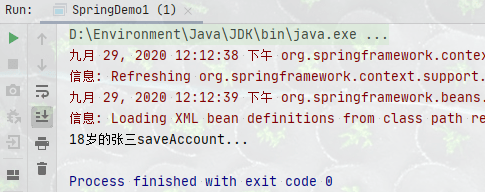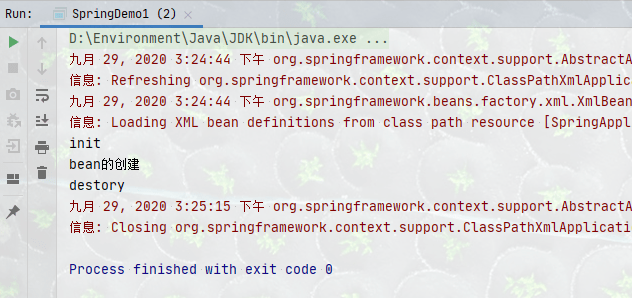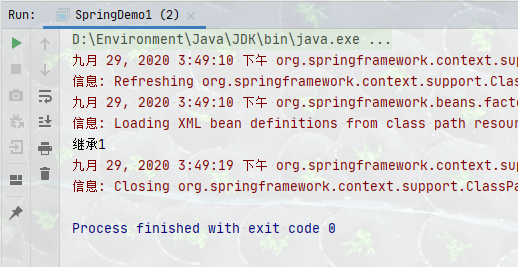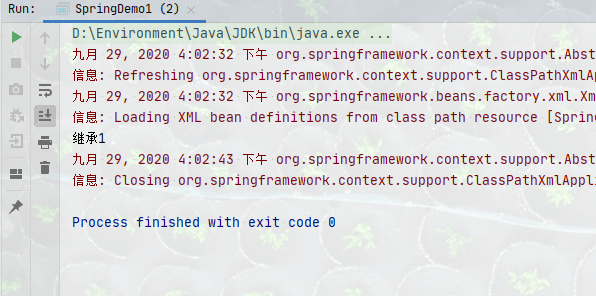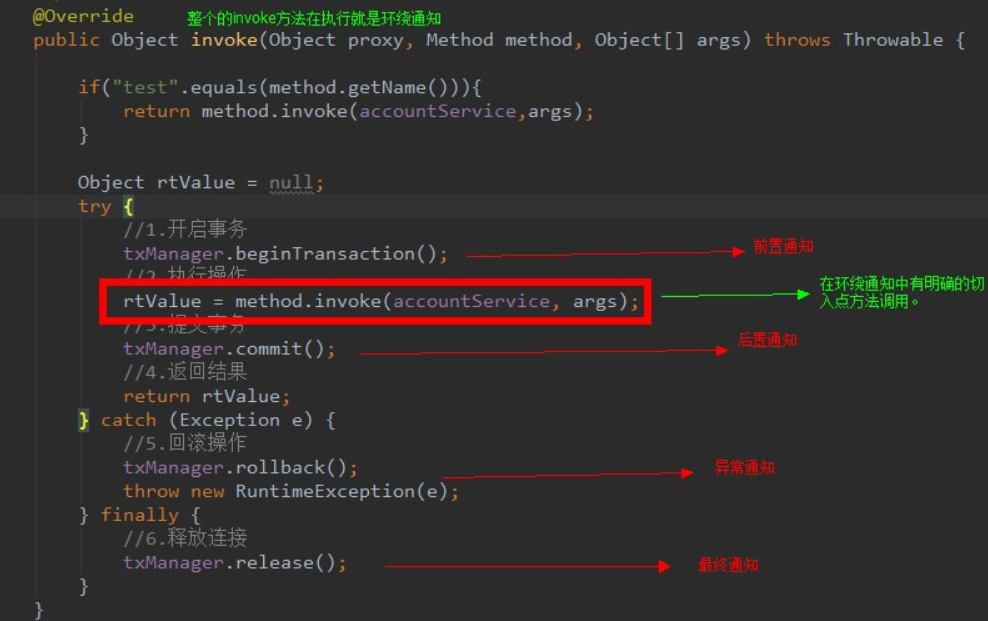 基础
基础
# Spring快速开始
# IOC
接下来我们要用Spring去实现上面我们解决的耦合问题,快速入门来体会一下Spring的感觉
1、准备持久层和业务层
package com.howling.SpringDemo1.Dao;
/**
* 持久层接口
*/
public interface AccountDao {
void saveAccount();
}
package com.howling.SpringDemo1.Dao;
/**
* 持久层
*/
public class AccountDaoImpl implements AccountDao {
public void saveAccount() {
System.out.println("持久化层接口");
}
}
package com.howling.SpringDemo1.Service;
/**
* 业务层接口
*/
public interface AccountService {
void saveAccount();
}
package com.howling.SpringDemo1.Service;
import com.howling.SpringDemo1.Dao.AccountDao;
import com.howling.SpringDemo1.Dao.AccountDaoImpl;
/**
* 业务层
*/
public class AccountServiceImpl implements AccountService {
private AccountDao accountDao = new AccountDaoImpl();
public void saveAccount() {
System.out.println("业务层调用持久化层");
accountDao.saveAccount();
}
}
2、导入Spring的依赖
<!--设置Spring-->
<dependency>
<groupId>org.springframework</groupId>
<artifactId>spring-context</artifactId>
<version>5.0.2.RELEASE</version>
</dependency>
3、准备bean对象的xml文件
<?xml version="1.0" encoding="UTF-8"?>
<beans xmlns="http://www.springframework.org/schema/beans"
xmlns:xsi="http://www.w3.org/2001/XMLSchema-instance"
xsi:schemaLocation="http://www.springframework.org/schema/beans
http://www.springframework.org/schema/beans/spring-beans.xsd">
<!--把对象的创建交给spring来管理
id:配置文件中的key值,与在讲工厂模式的时候的key值相同
class:配置文件中的value值,是全限定类名,与在讲工厂模式的时候的value值相同
-->
<bean id="accountService" class="com.howling.SpringDemo1.Service.AccountServiceImpl"></bean>
<bean id="accountDao" class="com.howling.SpringDemo1.Dao.AccountDaoImpl"></bean>
</beans>
4、使用Spring获取bean对象
- 改造Service
package com.howling.SpringDemo1.Service;
import com.howling.SpringDemo1.Dao.AccountDao;
import com.howling.SpringDemo1.Dao.AccountDaoImpl;
import org.springframework.context.ApplicationContext;
import org.springframework.context.support.ClassPathXmlApplicationContext;
/**
* 业务层
*/
public class AccountServiceImpl implements AccountService {
private static AccountDao accountDao = null;
static {
//获取bean.xml
ApplicationContext applicationContext = new ClassPathXmlApplicationContext("bean.xml");
//根据key获取对象
accountDao = applicationContext.getBean("accountDao", AccountDao.class);
}
public void saveAccount() {
System.out.println("业务层调用持久化层");
accountDao.saveAccount();
}
}
- 改造Controller
package com.howling.SpringDemo1;
import com.howling.SpringDemo1.Service.AccountService;
import org.springframework.context.ApplicationContext;
import org.springframework.context.support.ClassPathXmlApplicationContext;
/**
* 控制层
*/
public class SpringDemo1 {
public static void main(String[] args) {
//获取bean.xml文件
ApplicationContext applicationContext = new ClassPathXmlApplicationContext("bean.xml");
//根据key获取value,如果不指定Class则需要强制转换
AccountService accountService = (AccountService) applicationContext.getBean("accountService");
accountService.saveAccount();
}
}
5、查看结果
上面的快速开始就是Spring的IOC,控制反转,其实在作用上感觉非常像我们刚才写的单例工厂,不用怀疑,它就是。
学习Spring一定要把单例工厂弄个门清,至少要会手写单例工厂,让别人看看你的Spring学会了。
# Application和三种构造方法
下面我们来分析一下ApplicationContext

上面是ApplicationContext的体系结构,ApplicationContext是一个接口
1、我们可以看到他继承了BeanFactory
BeanFactory是Spring容器的顶层接口,他下面的实现接口有很多,其中我们常常使用的是ApplicationContext
2、ApplicationContext有三个比较常用的实现类
- ClassPathXmlApplicationContext:基于Xml的配置,刚才已经演示过了
- FileSystemXmlApplicationContext:也是基于Xml的配置
- AnnotationConfigApplicationContext:基于注解的配置
好的类和方法的命名让人一看就大体知道这个是干嘛的,比如
ClassPathXmlApplicationContext:根据ClassPath(类路径)的xml创建
FileSystemXmlApplicationContext:根据文件的xml来创建,但是必须要有访问权限
AnnotationConfigApplicationContext:基于注解配置来创建
BeanFactory和Application的两个加载策略
1、BeanFactory:是延迟加载,也就是说什么时候根据id加载了对象什么时候真正创建对象
这个其实想一下我们没有完成单例的工厂模式就很好理解了
所以这个模式下其实不是单例模式,每次调用工厂都会产出一个新的单例
BeanFactory主要是面向Spring本身
2、ApplicationContext:立即加载
这个就是我们改造完成之后的单例工厂了
每次调用工厂都是返回相同的实例
ApplicationContext主要是面向开发者
其实我推荐使用ApplicationContext,因为这个继承了BeanFactory和其他的接口,功能相对于BeanFactory更加强大。
但是Spring是一个非常牛逼的框架,他会根据你的配置进行更改。
# Spring的XML配置详解
# Spring的Bean细节
# Spring中bean.xml属性
- id:唯一标识
- name:名字,可以指定多个名字,使用逗号,分号,空格分隔
- class:映射的类,要用全类名
- scope:作用范围
- singleton:单例(默认值)
- prototype:多例(常用)
- request:作用于web应用的请求范围
- session:作用于web应用的会话范围
- global-session:作用于集群环境的会话范围(全局会话范围),当不是集群环境时他是session
- factory-method:可以让我们自己写bean的工厂,指定我们的方法来创建,有两种形式
- 静态方法
- 普通方法,需要借助factory-bean来使用
- factory-bean:指定工厂,说明这个类是工厂类
5、init-method:初始化要执行的方法
6、destory-method:销毁时要执行的方法
<bean id="" class="" factory-bean="" factory-method="" init-method="" destroy-method="" scope=""></bean>
这里只列出了部分,还有其他的后面都会一一讲到
# 三种创建Bean对象的方式
在上面的xml属性我们讲过了,其中可以看到,还有两种创建对象的属性:指定工厂和指定静态工厂
那么现在我们就有三种创建bean对象的方式了,在这里总结一下
1、根据默认的构造函数创建:默认使用。(这里简略写一下,反正前面都已经写过了)
- 编写类
/**
* 持久层
*/
public class AccountDaoImpl implements AccountDao {
public void saveAccount() {
System.out.println("持久化层接口");
}
}
- 指定spring的配置文件:bean.xml
<?xml version="1.0" encoding="UTF-8"?>
<beans xmlns="http://www.springframework.org/schema/beans"
xmlns:xsi="http://www.w3.org/2001/XMLSchema-instance"
xsi:schemaLocation="http://www.springframework.org/schema/beans
http://www.springframework.org/schema/beans/spring-beans.xsd">
<bean id="accountService" class="com.howling.SpringDemo1.Service.AccountServiceImpl"></bean>
<bean id="accountDao" class="com.howling.SpringDemo1.Dao.AccountDaoImpl"></bean>
</beans>
- Spring创建bean对象
/**
* 业务层
*/
public class AccountServiceImpl implements AccountService {
private static AccountDao accountDao = null;
static {
//获取bean.xml
ApplicationContext applicationContext = new ClassPathXmlApplicationContext("bean.xml");
//根据key获取对象
accountDao = applicationContext.getBean("accountDao", AccountDao.class);
}
public void saveAccount() {
System.out.println("业务层调用持久化层");
accountDao.saveAccount();
}
}
使用这种方式创建的bean对象会根据默认的构造函数进行创建,Spring直接通过反射给你创建一个
2、指定静态工厂创建
- 指定静态工厂
package com.howling.SpringDemo2.factory;
import com.howling.SpringDemo2.Dao.AccountDaoImpl;
import com.howling.SpringDemo2.Service.AccountServiceImpl;
public class BeanFactory {
public static AccountServiceImpl getAccountService() {
return new AccountServiceImpl();
}
public static AccountDaoImpl getAccountDao() {
return new AccountDaoImpl();
}
}
- 指定spring配置文件
<?xml version="1.0" encoding="UTF-8"?>
<beans xmlns="http://www.springframework.org/schema/beans"
xmlns:xsi="http://www.w3.org/2001/XMLSchema-instance"
xsi:schemaLocation="http://www.springframework.org/schema/beans
http://www.springframework.org/schema/beans/spring-beans.xsd">
<bean id="accountDao" class="com.howling.SpringDemo2.factory.BeanFactory"
factory-method="getAccountDao"></bean>
<bean id="accountService" class="com.howling.SpringDemo2.factory.BeanFactory"
factory-method="getAccountService"></bean>
</beans>
除了这两个地方,其他都不用动
3、指定工厂方法创建
- 指定工厂
package com.howling.SpringDemo3.factory;
import com.howling.SpringDemo3.Dao.AccountDaoImpl;
import com.howling.SpringDemo3.Service.AccountServiceImpl;
public class BeanFactory {
public AccountServiceImpl getAccountService() {
return new AccountServiceImpl();
}
public AccountDaoImpl getAccountDao() {
return new AccountDaoImpl();
}
}
- 指定Spring配置文件
<?xml version="1.0" encoding="UTF-8"?>
<beans xmlns="http://www.springframework.org/schema/beans"
xmlns:xsi="http://www.w3.org/2001/XMLSchema-instance"
xsi:schemaLocation="http://www.springframework.org/schema/beans
http://www.springframework.org/schema/beans/spring-beans.xsd">
<!--定义工厂-->
<bean id="beanFactory" class="com.howling.SpringDemo3.factory.BeanFactory"></bean>
<!--指定工厂和工厂中的方法-->
<bean id="accountDao" factory-bean="beanFactory" factory-method="getAccountDao"></bean>
<bean id="accountService" factory-bean="beanFactory" factory-method="getAccountService"></bean>
</beans>
现在可能有人要问了:这不是还是new出了对象了么,不还是耦合了么
原因在于:第二种和第三种的方式是解决jar包的方法的。jar包中的代码是.class文件不能更改,所以只能new
也就是说,要是你想通过Spring来获得jar包中的某个方法就可以使用第二种和第三种方式。
我们自己写的话直接使用第一种方式即可
# 作用范围
作用范围在bean.xml属性中也已经讲过了,简单来说就是配置一个scope属性即可
之前我们讲过BeanFactory和ApplicationContext的区别,说这两个一个是多例一个是单例,但是可以根据配置具体更改
这就是我们说过的那个配置
scope:作用范围
- singleton:单例(默认值)
- prototype:多例(常用)
- request:作用于web应用的请求范围
- session:作用于web应用的会话范围
- global-session:作用于集群环境的会话范围(全局会话范围),当不是集群环境时他是session
# 生命周期
友情提示,在看生命周期的时候,多想想我们之前写过的两个工厂,然后结合理解
多例对象的生命周期
出生:当使用对象时,对象创建
活着:当使用的时候活着
死亡:GC垃圾回收,Spring不管
单例对象的生命周期
出生:容器创建时立刻出生
活着:只要容器还在就一直活着
死亡:容器销毁,对象死亡
也就是说,单例对象的生命周期和容器的生命周期是完全一致的,只不过我们一般发现不了,因为main函数执行完成之后内存直接就释放了,也就是说容器还没来得及调用销毁方法就已经被释放了内存
但是我们想要手动关闭也是可以的,Spring中提供了关闭的方法,但是有个注意点
我们一般使用的接口是ApplicationContext,但是Application中并没有关闭的方法,只有它的子类才有,所以假如想要调用关闭的方法,使用多态是不可以的,比如下面这种就不可以
ApplicationContext context = new ClassPathXmlApplicationContext("bean.xml");
在传统的Java中,我们对于Bean的管理也就是new一个出来,然后用完等待GC,但是Spring中要考虑的显然不止这些东西,它的加载顺序还是比较复杂的
1、Bean的实例化:Spring启动,扫描需要被Spring管理的Bean,进行Bean的实例化
2、依赖注入:Bean实例化之后,对Bean的引入和值注入到Bean的属性中
3、注入Aware:Spring会检测是否实现了xxxAware接口,并将对应的Aware接口注入给Bean
4、BeanPostProcessor:经过上面的几个步骤,bean对象已经构造,但是在这个情况下还没有被使用
接口BeanPostProcessor下面有两个函数
- postProcessBeforeInitialzation:bean对象传进来,早于Initialzation,所以叫做前置处理,所有的Aware接口在这一步注入
- postProcessAfterInitialzation:bean对象传进来,晚于Initialzation,所以叫后置处理
5、InitializingBean与init-method:前置处理之后会执行这个,可以在这一步添加一些代码的逻辑,但是它不会把bean对象传进来,所以不能处理对象本身
6、DisposableBean和destroy-method:可以在bean销毁前执行逻辑,但是bean不会传递进来
# Spring依赖注入
# 依赖注入概述
什么叫做依赖注入
依赖注入:Dependency Injection
依赖注入的意思是:在当前类中需要用到其他类的对象,像这种依赖关系以后我们就都交给Spring去管理了,这种依赖关系的维护就叫做依赖注入
什么数据能够进行依赖注入
能够注入的数据分类三类
1、所有的基本类型和String
2、复杂类型(集合)
3、其他bean类型(在配置文件或者注解中配置过的bean)
注入的方式
依赖注入的方式有三种
1、构造函数
2、set方法
3、注解
经常要变化的数据是不适合注入的
# 构造函数注入
标签
构造函数的标签:<constructor-arg></constructor-arg>,其中有以下几个属性
- type:要注入的类型
- index:要注入数据的索引位置(构造函数上)
- name:要注入数据的名称呢过
- value:要注入数据的值
- ref:要注入数据的bean引用
构造函数注入的快速起步:基本类型的注入
1、写一个类,里面包含有参数的构造函数
package com.howling.ConstructorInjection.service;
public interface AccountService {
void saveAccount();
}
package com.howling.ConstructorInjection.service;
public class AccountServiceImpl implements AccountService {
private String name;
private Integer age;
/**
* 使用构造函数注入
*
* @param name name是String类型
* @param age age是Integer类型
*/
public AccountServiceImpl(String name, Integer age) {
this.name = name;
this.age = age;
}
public void saveAccount() {
System.out.println(this.age + "岁的" + this.name + "saveAccount...");
}
}
2、编写Spring的bean.xml
- ConstructorInjectionDemo1.xml
<?xml version="1.0" encoding="UTF-8"?>
<beans xmlns="http://www.springframework.org/schema/beans"
xmlns:xsi="http://www.w3.org/2001/XMLSchema-instance"
xsi:schemaLocation="http://www.springframework.org/schema/beans
http://www.springframework.org/schema/beans/spring-beans.xsd">
<!-- 1、首先使用一个bean对象指定对应的类,这个类初始化的时候需要带有参数 -->
<bean id="accountService" class="com.howling.ConstructorInjection.service.AccountServiceImpl">
<!-- 2、constructor-arg:构造函数注入方式
name:要注入的数据名称是什么
value:要制定基本类型和String类型的数据,可以自动转换,比如这个18会转为Integer
-->
<constructor-arg name="name" value="张三"></constructor-arg>
<constructor-arg name="age" value="18"></constructor-arg>
</bean>
</beans>
3、进行测试
package com.howling.ConstructorInjection;
import com.howling.ConstructorInjection.service.AccountServiceImpl;
import org.springframework.context.ApplicationContext;
import org.springframework.context.support.ClassPathXmlApplicationContext;
public class SpringDemo1 {
public static void main(String[] args) {
ApplicationContext context = new ClassPathXmlApplicationContext("ConstructorInjectionDemo1.xml");
AccountServiceImpl accountService = context.getBean("accountService", AccountServiceImpl.class);
accountService.saveAccount();
}
}
bean类型的注入
如果一个类A要依赖另一个类B,那么B首先要作为一个Spring管理的bean对象,然后才能被A引入,当然A也要成为一个bean对象
下面我们来做一个bean类型的注入
1、改造上面的类
package com.howling.ConstructorInjection.service;
import java.util.Date;
public class AccountServiceImpl implements AccountService {
private String name;
private Integer age;
/**
* 一个Date类,作为bean对象来注入
*/
private Date birthday;
public AccountServiceImpl(String name, Integer age, Date birthday) {
this.name = name;
this.age = age;
this.birthday = birthday;
}
public void saveAccount() {
System.out.println(this.age + "岁的" + this.name + "saveAccount..." + "要过他" + birthday + "的生日");
}
}
2、做一个bean对象
- xml
<?xml version="1.0" encoding="UTF-8"?>
<beans xmlns="http://www.springframework.org/schema/beans"
xmlns:xsi="http://www.w3.org/2001/XMLSchema-instance"
xsi:schemaLocation="http://www.springframework.org/schema/beans
http://www.springframework.org/schema/beans/spring-beans.xsd">
<!--我们做出了一个bean对象,Spring会使用反射初始化一个出来-->
<bean id="time" class="java.util.Date"></bean>
<bean id="accountService" class="com.howling.ConstructorInjection.service.AccountServiceImpl">
<constructor-arg name="name" value="张三"></constructor-arg>
<constructor-arg name="age" value="18"></constructor-arg>
<!-- name还是指定类中的值,但是bean对象不能指定value,要使用引用的方式 -->
<constructor-arg name="birthday" ref="time"></constructor-arg>
</bean>
</beans>
3、测试

可以看到,创建了一个Date对象
复杂类型的注入
复杂类型有这么几种
1、数组
2、集合
- List
- Map
3、Properties
所以我们根据数据的结构,分了两部分:
1、array和list
2、map和props
下面进行案例
1、改造类
package com.howling.ConstructorInjection.service;
import java.util.*;
public class AccountServiceImpl implements AccountService {
private String[] strings;
private List<String> list;
private Map<String, Object> map;
private Properties properties;
public AccountServiceImpl(String[] strings, List<String> list, Map<String, Object> map, Properties properties) {
this.strings = strings;
this.list = list;
this.map = map;
this.properties = properties;
}
@Override
public void saveAccount() {
Arrays.stream(strings).forEach(System.out::print);
System.out.println();
list.forEach(System.out::print);
System.out.println();
map.keySet().forEach(System.out::print);
System.out.println();
properties.keySet().forEach(System.out::print);
}
}
2、xml改造
<?xml version="1.0" encoding="UTF-8"?>
<beans xmlns="http://www.springframework.org/schema/beans"
xmlns:xsi="http://www.w3.org/2001/XMLSchema-instance"
xsi:schemaLocation="http://www.springframework.org/schema/beans
http://www.springframework.org/schema/beans/spring-beans.xsd">
<bean id="accountService" class="com.howling.ConstructorInjection.service.AccountServiceImpl">
<!--参数1:数组:array-value-->
<constructor-arg index="0">
<array>
<value>a1</value>
<value>a2</value>
<value>a3</value>
</array>
</constructor-arg>
<!--参数2:列表:list-value-->
<constructor-arg index="1">
<list>
<value>l1</value>
<value>l2</value>
<value>l3</value>
</list>
</constructor-arg>
<!--参数3:map:map-entry(key-value)-->
<constructor-arg index="2">
<map>
<entry key="m1" value="m1"/>
<entry key="m2" value="m2"/>
<entry key="m3" value="m3"/>
</map>
</constructor-arg>
<!--参数4:properties-->
<constructor-arg index="3">
<props>
<prop key="p1">1</prop>
<prop key="p2">2</prop>
<prop key="p3">3</prop>
</props>
</constructor-arg>
</bean>
</beans>
3、测试
package com.howling.ConstructorInjection;
import com.howling.ConstructorInjection.service.AccountServiceImpl;
import org.springframework.context.ApplicationContext;
import org.springframework.context.support.ClassPathXmlApplicationContext;
public class SpringDemo1 {
public static void main(String[] args) {
ApplicationContext context = new ClassPathXmlApplicationContext("ConstructorInjectionDemo1.xml");
AccountServiceImpl accountService = context.getBean("accountService", AccountServiceImpl.class);
accountService.saveAccount();
}
}
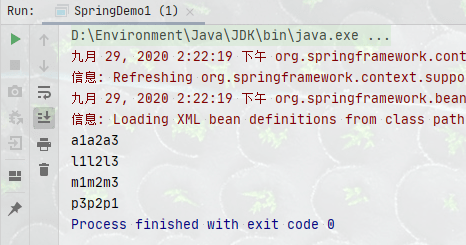
# set注入
Set注入概述
简单来说,就是将构造方法的注入转换为了set方法注入(不需要get方法)
标签
Set方法的标签是<property></property>,主要有这么几个属性
1、name:从set方法中得到的名字,比如:setName-->Name-->name
2、value:值
3、ref:注入数据的bean引用
没错,set注入直接就是property,而且set注入是最常用的一种注入方式
实例
1、代码改造
package com.howling.ConstructorInjection.service;
import java.util.*;
public class AccountServiceImpl implements AccountService {
private String name;
private Integer age;
private Date birthday;
private String[] strings;
private List<String> list;
private Map<String, Object> map;
private Properties properties;
public void setName(String name) {
this.name = name;
}
public void setAge(Integer age) {
this.age = age;
}
public void setBirthday(Date birthday) {
this.birthday = birthday;
}
public void setStrings(String[] strings) {
this.strings = strings;
}
public void setList(List<String> list) {
this.list = list;
}
public void setMap(Map<String, Object> map) {
this.map = map;
}
public void setProperties(Properties properties) {
this.properties = properties;
}
@Override
public void saveAccount() {
Arrays.stream(strings).forEach(System.out::print);
System.out.println();
list.forEach(System.out::print);
System.out.println();
map.keySet().forEach(System.out::print);
System.out.println();
properties.keySet().forEach(System.out::print);
}
}
2、xml
<?xml version="1.0" encoding="UTF-8"?>
<beans xmlns="http://www.springframework.org/schema/beans"
xmlns:xsi="http://www.w3.org/2001/XMLSchema-instance"
xsi:schemaLocation="http://www.springframework.org/schema/beans
http://www.springframework.org/schema/beans/spring-beans.xsd">
<bean id="time" class="java.util.Date"></bean>
<bean id="accountService" class="com.howling.ConstructorInjection.service.AccountServiceImpl">
<!-- 1、基础类型和字符串 -->
<property name="name" value="张三"></property>
<property name="age" value="18"></property>
<!--bean类型-->
<property name="birthday" ref="time"></property>
<!--复杂类型-->
<property name="strings">
<array>
<value>1</value>
<value>2</value>
<value>3</value>
</array>
</property>
<property name="list">
<list>
<value>1</value>
<value>2</value>
<value>3</value>
</list>
</property>
<property name="map">
<map>
<entry key="1" value="1"></entry>
<entry key="2" value="2"></entry>
<entry key="3" value="3"></entry>
</map>
</property>
<property name="properties">
<props>
<prop key="1">1</prop>
<prop key="2">2</prop>
<prop key="3">3</prop>
</props>
</property>
</bean>
</beans>
3、测试
package com.howling.ConstructorInjection;
import com.howling.ConstructorInjection.service.AccountServiceImpl;
import org.springframework.context.ApplicationContext;
import org.springframework.context.support.ClassPathXmlApplicationContext;
public class SpringDemo1 {
public static void main(String[] args) {
ApplicationContext context = new ClassPathXmlApplicationContext("ConstructorInjectionDemo1.xml");
AccountServiceImpl accountService = context.getBean("accountService", AccountServiceImpl.class);
accountService.saveAccount();
}
}
# Spring的注解详解
# 注解概述
首先明确一件事情:注解的方式和xml的方式本质上没有什么区别
注解按照作用分类
- 用于创建对象
- 改变作用范围
- 和生命周期相关
- 用于注入数据
# 环境准备
首先我们需要告诉Spring:我要用注解。
回想一下我们学习的JavaWeb,我们使用注解的使用是首先在web.xml上填写使用注解的命名空间,在Spring中也是这么干,那么我们的xml需要换成下面这个
<beans xmlns="http://www.springframework.org/schema/beans"
xmlns:xsi="http://www.w3.org/2001/XMLSchema-instance"
xmlns:context="http://www.springframework.org/schema/context"
xsi:schemaLocation="http://www.springframework.org/schema/beans
https://www.springframework.org/schema/beans/spring-beans.xsd
http://www.springframework.org/schema/context
https://www.springframework.org/schema/context/spring-context.xsd">
<context:component-scan base-package="com.howling"></context:component-scan>
</beans>
1、我们需要beans的命名空间
2、component-scan中的base-package告诉了Spring在创建容器要扫描com.howling下面的包
3、当扫描包的时候就会发现包中的类上的注解
# 创建对象的注解
注解说明
1、@Component:组件
2、@Controller:一般用于控制层(表现层)
3、@Service:一般用于业务层
4、@Repository:一般用于持久层
说明一下,其实上面这四个的作用都是一样的,但是分开命名就是让我们程序员开发的时候比较好理解,但是其实用啥都一样
属性说明
注解肯定要有属性,属性名就是value,属性值是唯一的,用于找到这个类
1、当不写value时,默认value是类的小驼峰形式
package com.howling.Annotation.service;
import org.springframework.stereotype.Component;
@Component
public class AccountServiceImpl implements AccountService {
public void saveAccount() {
System.out.println("bean的创建");
}
}
这里的value就是accountServiceImpl
2、当自定义value时,就是你自己定义的值
package com.howling.Annotation.service;
import org.springframework.stereotype.Component;
@Component(value = "accountService")
public class AccountServiceImpl implements AccountService {
public void saveAccount() {
System.out.println("bean的创建");
}
}
package com.howling.Annotation.service;
import org.springframework.stereotype.Component;
@Component("accountService")
public class AccountServiceImpl implements AccountService {
public void saveAccount() {
System.out.println("bean的创建");
}
}
因为只有一个value赋值,所以value写不写都行
例子
package com.howling.Annotation.service;
import org.springframework.stereotype.Component;
@Component
public class AccountServiceImpl implements AccountService {
public void saveAccount() {
System.out.println("bean的创建");
}
}
package com.howling.Annotation;
import com.howling.Annotation.service.AccountServiceImpl;
import org.springframework.context.ApplicationContext;
import org.springframework.context.support.ClassPathXmlApplicationContext;
public class SpringDemo1 {
public static void main(String[] args) {
ApplicationContext context = new ClassPathXmlApplicationContext("SpringApplication.xml");
AccountServiceImpl accountServiceImpl = context.getBean("accountServiceImpl", AccountServiceImpl.class);
accountServiceImpl.saveAccount();
}
}
# 作用范围
注解
@Scope:指定bean的作用范围
属性
value:指定范围的取值
- singleton:单例,默认
- prototype:多例
例子
package com.howling.Annotation.service;
import org.springframework.context.annotation.Scope;
import org.springframework.stereotype.Component;
@Component
@Scope("prototype")
public class AccountServiceImpl implements AccountService {
public void saveAccount() {
System.out.println("bean的创建");
}
}
# 生命周期
注解
- @PostConstruct:初始化要执行的方法
- @PreDestory:销毁前要执行的方法
1、这俩都用在方法上
2、不能用多态来测试销毁方法,因为ApplicationContext没有这个方法,子类才有
3、多例模式下GC回收,close也没用
4、详情查看Spring的生命周期
package com.howling.Annotation.service;
import org.springframework.context.annotation.Scope;
import org.springframework.stereotype.Component;
import javax.annotation.PostConstruct;
import javax.annotation.PreDestroy;
@Component
public class AccountServiceImpl implements AccountService {
public void saveAccount() {
System.out.println("bean的创建");
}
@PostConstruct
void init(){
System.out.println("init");
}
@PreDestroy
void destory(){
System.out.println("destory");
}
}
package com.howling.Annotation;
import com.howling.Annotation.service.AccountServiceImpl;
import org.springframework.context.support.ClassPathXmlApplicationContext;
public class SpringDemo1 {
public static void main(String[] args) {
ClassPathXmlApplicationContext context = new ClassPathXmlApplicationContext("SpringApplication.xml");
AccountServiceImpl accountServiceImpl = context.getBean("accountServiceImpl", AccountServiceImpl.class);
accountServiceImpl.saveAccount();
context.close();
}
}
# 注入数据
# 注解分类
- @Autowried:先按照类型匹配,然后按照bean的id注入
- @Qualifier:给类成员注入和@Autowried一起使用,给方法参数注入可以单独使用
- @Resource:根据bean的id注入,不是Spring的注解
- @Value:注入基本类型和String
# @Autowried
这个注解会首先按照类型匹配,假如只有一个匹配的类型就按照那个类型注入,假如有多个匹配的类型就按照名称注入
而且@Autowried会调用的是无参构造,所以是这样的:类型-->名称-->无参构造
而且假如只有有参构造没有无参构造,它也没法调用,因为没有值给它调用
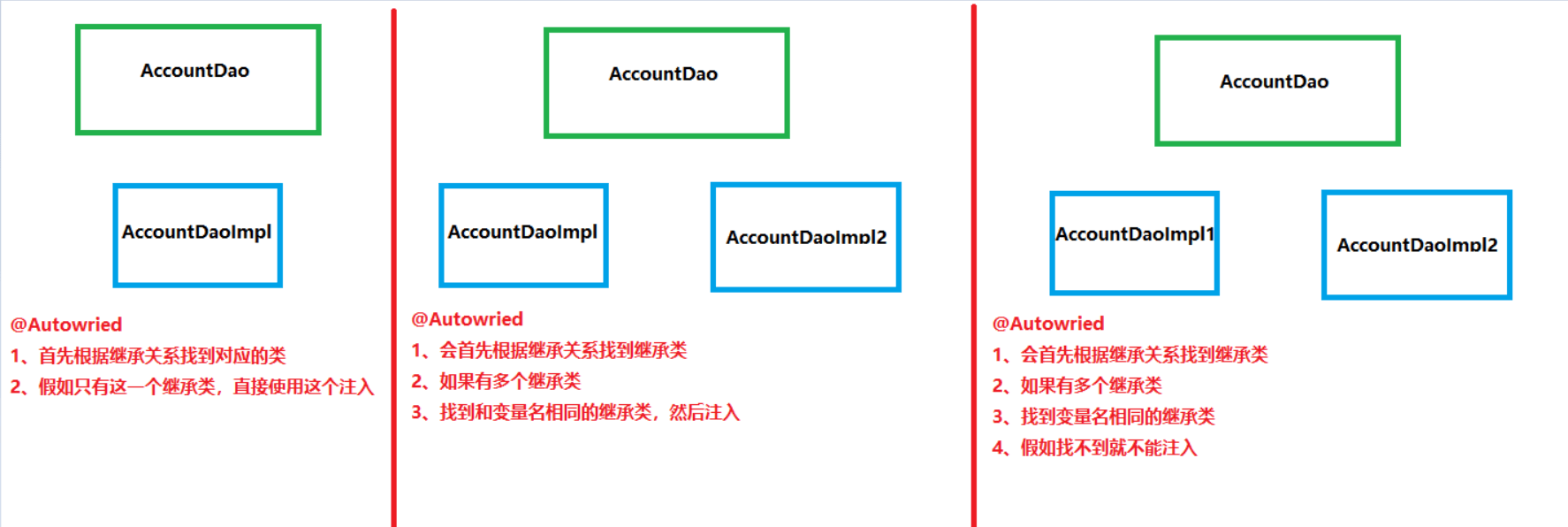
下面来进行情景一:只有一个继承类
package com.howling.Annotation.dao;
import org.springframework.stereotype.Repository;
@Repository
public class AccountDaoImpl implements AccountDao{
public void saveAccount() {
System.out.println("继承1");
}
}
package com.howling.Annotation.service;
import com.howling.Annotation.dao.AccountDao;
import org.springframework.beans.factory.annotation.Autowired;
import org.springframework.stereotype.Component;
@Component
public class AccountServiceImpl implements AccountService {
@Autowired
private AccountDao accountDao = null;
public void saveAccount() {
System.out.println("bean的创建");
}
}
情景二:多个继承类
package com.howling.Annotation.dao;
import org.springframework.stereotype.Repository;
@Repository
public class AccountDaoImpl implements AccountDao{
public void saveAccount() {
System.out.println("继承1");
}
}
package com.howling.Annotation.dao;
import org.springframework.stereotype.Repository;
@Repository
public class AccountDaoImpl2 implements AccountDao {
public void saveAccount() {
System.out.println("继承2");
}
}
package com.howling.Annotation.service;
import com.howling.Annotation.dao.AccountDao;
import org.springframework.beans.factory.annotation.Autowired;
import org.springframework.stereotype.Component;
@Component
public class AccountServiceImpl implements AccountService {
@Autowired
private AccountDao accountDao = null;
public void saveAccount() {
System.out.println("bean的创建");
}
}
accountDao是名字,@Autowried也会根据这个名字去找对应的类,但是很遗憾找不到,所以注入不进去
在这里要注意一件事情,两个类都要去交给Spring管理,也就是说都要加上注解,要不然白写
情景三:有相同的bean名字
package com.howling.Annotation.dao;
import org.springframework.stereotype.Repository;
@Repository
public class AccountDaoImpl implements AccountDao{
public void saveAccount() {
System.out.println("继承1");
}
}
package com.howling.Annotation.dao;
import org.springframework.stereotype.Repository;
@Repository
public class AccountDaoImpl2 implements AccountDao {
public void saveAccount() {
System.out.println("继承2");
}
}
package com.howling.Annotation.service;
import com.howling.Annotation.dao.AccountDao;
import org.springframework.beans.factory.annotation.Autowired;
import org.springframework.stereotype.Component;
@Component
public class AccountServiceImpl implements AccountService {
@Autowired
private AccountDao accountDaoImpl = null;
public void saveAccount() {
System.out.println("bean的创建");
}
}
# @Qualifier
- 给类成员注入的使用要和@Autowried配合使用,目的是为了消除歧义
- 给方法参数注入可以单独使用,这里不讲,不好举例子
给类成员注入
我们之前看过@Autowried在多个继承类下要去找和属性名一致的bean的id,但是加入找不到就会报错
这个时候我们可以和@Qualifier配合,@Qualifier用于指定你要指定的bean的id
package com.howling.Annotation.service;
import com.howling.Annotation.dao.AccountDao;
import org.springframework.beans.factory.annotation.Autowired;
import org.springframework.beans.factory.annotation.Qualifier;
import org.springframework.stereotype.Component;
@Component
public class AccountServiceImpl implements AccountService {
@Autowired
@Qualifier("accountDaoImpl")
private AccountDao accountDao = null;
public void saveAccount() {
accountDao.saveAccount();
}
}
这个时候假如有多个值,直接会找accountDaoImpl,即使有一个叫做accountDao的也会找accountDaoImpl
# @Resource
@Resource其实就是@Autowried和@Qualifier的结合体,他直接根据bean的id注入,所以bean的id是必须写的
package com.howling.Annotation.service;
import com.howling.Annotation.dao.AccountDao;
import org.springframework.stereotype.Component;
import javax.annotation.Resource;
@Component
public class AccountServiceImpl implements AccountService {
@Resource(name = "accountDaoImpl")
private AccountDao accountDaoImpl2 = null;
public void saveAccount() {
accountDaoImpl2.saveAccount();
}
}
# @Value
@Value注解可以给属性赋值,有几种方式:
1、直接赋值
2、使用SpEL表达式赋值
3、读取配置文件赋值
下面依次来讲解(下面以基本类型来演示,但其实你完全可以使用复杂类型)
直接赋值
package com.howling.Annotation.service;
import org.springframework.beans.factory.annotation.Value;
import org.springframework.stereotype.Component;
@Component
public class AccountServiceImpl implements AccountService {
@Value("18")
private Integer age;
public void saveAccount() {
System.out.println(age);
}
}
注意,这种方式可以直接写在属性上,有set方法也可以卸载set方法上
使用SpEL表达式赋值
package com.howling.Annotation.domain;
import org.springframework.beans.factory.annotation.Value;
import org.springframework.stereotype.Component;
@Component
public class User {
private String username;
@Value("张三")
public void setUsername(String username) {
this.username = username;
}
public String getUsername() {
return username;
}
}
package com.howling.Annotation.service;
import org.springframework.beans.factory.annotation.Value;
import org.springframework.stereotype.Component;
@Component
public class AccountServiceImpl implements AccountService {
@Value("#{user.username}")
private String username;
public void saveAccount() {
System.out.println(username);
}
}
通过SpEL表达式来进行其他类的读取,但是注意要有get方法,它是这样的user.username-->user.getUserName()
通过get方法来读取
读取配置文件赋值
1、首先需要在Spring的配置文件上加上一句话
<beans xmlns="http://www.springframework.org/schema/beans"
xmlns:xsi="http://www.w3.org/2001/XMLSchema-instance"
xmlns:context="http://www.springframework.org/schema/context"
xsi:schemaLocation="http://www.springframework.org/schema/beans
https://www.springframework.org/schema/beans/spring-beans.xsd
http://www.springframework.org/schema/context
https://www.springframework.org/schema/context/spring-context.xsd">
<!-- 表示读取classpath下面的application.properties文件 -->
<context:property-placeholder location="classpath:application.properties">
</context:property-placeholder>
<context:component-scan base-package="com.howling"></context:component-scan>
</beans>
关于classpath在编译前后的对应关系我有一篇闲谈
2、application.properties文件
address=Asia/Shanghai
3、编写bean
package com.howling.Annotation.service;
import org.springframework.beans.factory.annotation.Value;
import org.springframework.stereotype.Component;
@Component
public class AccountServiceImpl implements AccountService {
@Value("${address}")
private String address;
public void saveAccount() {
System.out.println(address);
}
}
下面来看一下效果

# 其他注解
# 注解概述
1、@Configuration:指定配置类,主要作用是完全摆脱xml
2、@ComponentScan:指定创建容器时要扫描的包,在前面已经讲过了
3、@Bean:放在方法上,作用是将方法的返回值作为bean对象存到IOC容器里
4、@Import:在一个配置类中引入其他的配置类
5、@PropertySource:用于指定properties文件的路径,路径是编译后的classpath下的
6、@PropertySources:下面有多个@PropertySource
# @Configuration
我们之前使用注解都是首先在配置文件上声明:我要用注解了,然后采用的注解。但是这种方式始终离不开xml注解。
我们在一开始讲过的创建IOC容器的时候说过,ApplicationContext由三个实现方法,我们之前一直用的是xml的方法,现在我们要换为注解的方法:new AnnotationConfigApplicationContext(配置类.class),使用这个方法就可以完全脱离xml了。
但是使用这个方法的配置就需要一个配置类,我们的配置类声明的注解为:@Configuration
下面来测试一下
1、编写配置类
package com.howling.config;
import org.springframework.context.annotation.ComponentScan;
import org.springframework.context.annotation.Configuration;
/**
* @Configuration:加到类上,说明这个类是配置类
* @ComponentScan("com.howling"):指定注解要扫描的包,和xml中指定的是一个道理
*/
@Configuration
@ComponentScan("com.howling")
public class SpringConfiguration {
}
2、编写Service
package com.howling.servlet;
import org.springframework.stereotype.Service;
@Service
public class AccountServiceImpl implements AccountService {
public void saveAccount() {
System.out.println("saveAccount");
}
}
3、测试
package com.howling;
import com.howling.config.SpringConfiguration;
import com.howling.servlet.AccountServiceImpl;
import org.springframework.context.ApplicationContext;
import org.springframework.context.annotation.AnnotationConfigApplicationContext;
public class SpringDemo4 {
public static void main(String[] args) {
ApplicationContext context =
new AnnotationConfigApplicationContext(SpringConfiguration.class);
AccountServiceImpl accountServiceImpl =
context.getBean("accountServiceImpl", AccountServiceImpl.class);
accountServiceImpl.saveAccount();
}
}
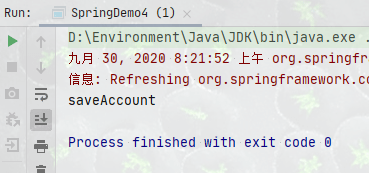
4、其他说明
我们在controller中
new AnnotationConfigApplicationContext(SpringConfiguration.class);这一步已经将SpringConfiguration这个类的class字节码加载进去了,所以其实在这个类上不写@Configuration也是可以的
但是其他的情况是需要写的,比如配置类A中引用了配置类B,然后在创建的时候引入了配置类A。这个时候虽然引用的是配置类A,但是和上面不同,这里必须写上注解。
顺便说明一下,A调用B是有可能的,只需要在A中的注解改动一下:@Configuration("要扫描的包","配置类2")
为了我们的规范使用,建议不管怎么样都要加上@Configuration这个注解,但是看到没有加上注解也不要奇怪
# @Import
在刚才,我们在最后说了配置类A调用配置类B是可以的,但是@Configuration("要扫描的包","配置类2"),像这种方式是非常不好用的,我们有一种更好的方式,就是使用注解@Import(字节码)
使用这种方式,我们就可以在配置类A中引入配置类B,将其整合到一个配置中
package com.howling.config;
import org.springframework.context.annotation.Configuration;
@Configuration
public class ConfigurationB {
}
package com.howling.config;
import org.springframework.context.annotation.ComponentScan;
import org.springframework.context.annotation.Configuration;
import org.springframework.context.annotation.Import;
/**
* @Configuration:加到类上,说明这个类是配置类
* @ComponentScan("com.howling"):指定注解要扫描的包,和xml中指定的是一个道理
*/
@Configuration
@ComponentScan("com.howling")
@Import(ConfigurationB.class)
public class SpringConfiguration {
}
# @PropertySource
关于这个注解,其实前面我们已经提了一嘴,就是可以指定properties文件的路径,只需要指定classpath下面的properties文件即可
关于classpath虽然说了很多遍但是还要再说一遍,在项目编译后java和resources目录下的文件都会到classes下面,这个classes就是我们说的classpath
举个例子
1、application.properties
address=Asia/Shanghai
2、配置类
package com.howling.config;
import org.springframework.context.annotation.Configuration;
import org.springframework.context.annotation.PropertySource;
@Configuration
@PropertySource("classpath:application.properties")
public class ConfigurationB {
}
package com.howling.config;
import org.springframework.context.annotation.ComponentScan;
import org.springframework.context.annotation.Configuration;
import org.springframework.context.annotation.Import;
@Configuration
@ComponentScan("com.howling")
@Import(ConfigurationB.class)
public class SpringConfiguration {
}
3、service
package com.howling.servlet;
import org.springframework.beans.factory.annotation.Value;
import org.springframework.stereotype.Service;
@Service
public class AccountServiceImpl implements AccountService {
@Value("${address}")
private String address;
public void saveAccount() {
System.out.println(address);
}
}
4、演示
package com.howling;
import com.howling.config.SpringConfiguration;
import com.howling.servlet.AccountServiceImpl;
import org.springframework.context.ApplicationContext;
import org.springframework.context.annotation.AnnotationConfigApplicationContext;
public class SpringDemo4 {
public static void main(String[] args) {
ApplicationContext context = new AnnotationConfigApplicationContext(SpringConfiguration.class);
AccountServiceImpl accountServiceImpl = context.getBean("accountServiceImpl", AccountServiceImpl.class);
accountServiceImpl.saveAccount();
}
}
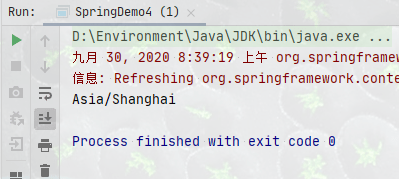
# Spring整合Junit
Junit这么厉害是因为Junit集成了main方法,Junit不管我们是否采用了什么框架,他只会执行@Test注解上的内容
所以问题来了,Junit不知道我们使用了Spring,没法注入,所以我们需要想个办法,能让Junit在单元测试的时候能够注入
我们使用的方式是替换掉Junit中内置的main方法,这样就可以实现注入了
1、导入环境
<!--替换Junit的main方法让Spring能够在单元测试中注入-->
<dependency>
<groupId>org.springframework</groupId>
<artifactId>spring-test</artifactId>
<version>5.0.2.RELEASE</version>
</dependency>
<!-- Junit -->
<dependency>
<groupId>junit</groupId>
<artifactId>junit</artifactId>
<version>4.13</version>
</dependency>
当使用Spring5.x的时候,Junit必须在4.12及以上,否则会报错
2、使用注解@RunWith(SpringJunit4ClassRunner.class)替换掉main方法
3、告知Spring运行器,Spring的IOC是基于xml还是基于注解,并且说明位置
- locations:指定xml所在目录,加上classpath关键字表示在类路径下
- classes:指定注解类所在的位置
4、测试
package howling;
import com.howling.servlet.AccountService;
import org.junit.Test;
import org.junit.runner.RunWith;
import org.springframework.beans.factory.annotation.Autowired;
import org.springframework.test.context.ContextConfiguration;
import org.springframework.test.context.junit4.SpringJUnit4ClassRunner;
@RunWith(SpringJUnit4ClassRunner.class)
@ContextConfiguration(classes = com.howling.config.SpringConfiguration.class)
//@ContextConfiguration(locations = "classpath:SpringConfiguration.xml"):使用xml时
public class TestJunit {
@Autowired
private AccountService accountService;
@Test
public void account(){
accountService.saveAccount();
}
}
# AOP
# 动态代理
# 动态代理概述
代理:在生活中,我们遇到了很多代理,比如买电脑买手机,找售后都是找代理。代理去代理厂家的产品,厂家卖的多,代理也抽成。
在Java中也有类似的概念,回想一下反射的内容,我们就很容易理解
动态代理:和代理差不多,不过更加高级一些
1、字节码随用随创建,随用随加载
2、不修改源码的基础上对方法继承增强
3、可以分类为:基于接口的动态代理,基于子类的动态代理
# 基于接口的动态代理
基于接口的动态代理,由JDK提供,需要Proxy类,这里是回顾前面讲过的反射的内容,更加具体的去看反射
1、首先我们来写厂家
package com.howling.proxy;
/**
* 这里是厂家的接口,有一个方法是销售的方法
*/
public interface Producer {
public void saleProducer(float money);
}
package com.howling.proxy;
/**
* 厂家的实现
*/
public class ProducerImpl implements Producer {
/**
* 厂家进行销售
*
* @param money
*/
public void saleProducer(float money) {
System.out.println("厂家赚得:" + money + "元");
}
}
2、我们来写代理和测试
package com.howling.proxy;
import java.lang.reflect.InvocationHandler;
import java.lang.reflect.Method;
import java.lang.reflect.Proxy;
/**
* 模拟消费者进行消费
*/
public class Client {
public static void main(String[] args) {
//必须是final修饰才可以被代理
final ProducerImpl producerImpl = new ProducerImpl();
//动态代理,也就是我们模拟的代理商
Producer producer = (Producer) Proxy.newProxyInstance(producerImpl.getClass().getClassLoader(), producerImpl.getClass().getInterfaces(), new InvocationHandler() {
public Object invoke(Object proxy, Method method, Object[] args) throws Throwable {
//假如当前执行的方法是saleProducer
if ("saleProducer".equals(method.getName())) {
float money = (Float) args[0];//读取参数值
//代理商进行抽成
money *= 0.8;
System.out.println("代理商抽两成的利润");
//返回代理商的方法
return method.invoke(producerImpl, money);
}
return method.invoke(method,args);
}
});
//消费者去代理商那里进行购买,花了一万块
producer.saleProducer(10000f);
}
}
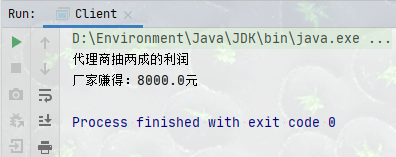
3、下面来讲一下几个参数
Proxy.newProxyInstance(ClassLoader,Class[],InvocationHandler)
1、类加载器,被代理的类的类加载器
2、字节码数组,这个的作用是让代理对象和被代理的对象有相同的方法,所以需要被代理对象的父级接口
3、提供增强代码,使用InvocationHandler(proxy,method,args)
1、proxy:当前被代理对象的引用,也就是InvocationHandler本身
2、method:当前方法的名称
3、args:当前执行的方法中的参数数组
# 基于子类的动态代理
基于子类的动态代理,我们需要一个外部的包CGLIB,他是一个功能强,性能高的代码生成包。
主要是为没有实现接口的类实现代理,算是对JDK代理的一个很好的补充。
1、依赖
<dependency>
<groupId>cglib</groupId>
<artifactId>cglib</artifactId>
<version>2.1_3</version>
</dependency>
2、编写生产者,这里就不需要写接口了
package com.howling.cglib;
/**
* 生产者
*/
public class Producer {
/**
* 实现销售方法
* @param money
*/
public void saleProducer(float money){
System.out.println("销售"+money+"...");
}
}
3、编写消费者
package com.howling.cglib;
import net.sf.cglib.proxy.Enhancer;
import net.sf.cglib.proxy.MethodInterceptor;
import net.sf.cglib.proxy.MethodProxy;
import java.lang.reflect.Method;
/**
* 模拟消费者
*/
public class Client {
public static void main(String[] args) {
final Producer producer = new Producer();
Producer proxyProducer = (Producer) Enhancer.create(producer.getClass(), new MethodInterceptor() {
public Object intercept(Object o, Method method, Object[] objects, MethodProxy methodProxy) throws Throwable {
if ("saleProducer".equals(method.getName())){
float money = (Float) objects[0];
return method.invoke(producer,money*0.8f);
}
return null;
}
});
proxyProducer.saleProducer(10000f);
}
}
4、结果

# AOP概述
1、AOP:面向切面编程,通过预编译和运行期动态代理实现程序功能统一维护的技术
2、AOP是OOP(面向对象)的延伸,是软件开发的一个热点
3、AOP是Spring中的一个重要内容,是函数式编程的一种衍生模型
4、利用AOP可以对业务逻辑的各个部分进行隔离,从而使业务逻辑的各个部分之间的耦合度降低,提高程序的可重用性
优势:减少重复代码,提高开发效率,维护方便
AOP有以下术语
1、连接点:JoinPoint:所谓连接点是那些被拦截到的点,在Spring中是方法,因为Spring只支持方法类型的连接点
也就是我们所说的要增强的方法
2、切入点:Pointcut:所为切入点是指我们要对哪些连接点进行拦截的定义
在事务中被增强的方法就叫做切入点
注意连接点和切入点的区别,连接点指的就是原来定义的方法,切入点指的是我们已经明确进行拦截的方法
3、通知:Active:拦截到连接点之后要做的事情
通知也就是指的增强,通知分为:前置通知,后置通知,异常通知,最终通知
现在想一下我们在JDK动态代理中的的invoke方法
public Object invoke(Object proxy, Method method, Object[] args) throws Throwable {
//假如当前执行的方法是saleProducer
if ("saleProducer".equals(method.getName())) {
float money = (Float) args[0];//读取参数值
//代理商进行抽成
money *= 0.8;
System.out.println("代理商抽两成的利润");
//返回代理商的方法
return method.invoke(producerImpl, money);
}
return method.invoke(method,args);
}
method.invoke(producerImpl, money)这段代码也就是我们最终要执行的方法,也就是我们的切入点,看好这个切入点1、在切入点之前的代码的都是前置通知
2、在切入点之后的都是后置通知
3、出现异常,被捕获的都叫做异常通知
4、不论如何都要执行的就是最终通知
5、整个invoke方法就是环绕通知
如图:
4、引介:Introduction:引介是一种特殊的通知,在不改变类代码的前提下,引介可以在运行期为类动态地添加一些方法或者成员变量
5、目标对象:Target:代理的目标对象
6、织入:Weaving:指把增强应用到目标对象来创建新的代理对象的过程,Spring使用动态代理,而AspectJ使用编译器和类装载器
7、代理:Proxy:一个类被织入之后,就会产生一个结果代理类
8、切面:Aspect:切入点+通知=切面
AOP其实非常简单,我们只需要
1、编写核心业务代码
2、抽取公共代码,制作为通知
3、在配置文件中声明切入点和通知的关系(切面)
# 基于XML的AOP配置
# 快速起步
1、pom.xml
<!--Spring-->
<dependency>
<groupId>org.springframework</groupId>
<artifactId>spring-context</artifactId>
<version>5.0.2.RELEASE</version>
</dependency>
<!--用于解析切入点表达式-->
<dependency>
<groupId>org.aspectj</groupId>
<artifactId>aspectjweaver</artifactId>
<version>1.8.7</version>
</dependency>
2、service
package com.howling.aop.service;
/**
* 对账户的操作
*/
public interface AccountService {
/**
* 模拟保存操作
*/
void saveAccount();
/**
* 模拟更新操作
*
* @param i
*/
void updateAccount(int i);
/**
* 模拟删除操作
*
* @return
*/
int deleteAccount();
}
package com.howling.aop.service;
public class AccountServiceImpl implements AccountService {
public void saveAccount() {
System.out.println("用户已保存");
}
public void updateAccount(int i) {
System.out.println("用户已更新" + i);
}
public int deleteAccount() {
System.out.println("用户已删除");
return 0;
}
}
3、通知
package com.howling.aop.utils;
/**
* 模拟日志记录的工具类,一会就会将此方法进行织入
*/
public class Logger {
public void printLogger() {
System.out.println("日志已经开始记录...");
}
}
4、xml配置
<?xml version="1.0" encoding="UTF-8"?>
<beans xmlns="http://www.springframework.org/schema/beans"
xmlns:xsi="http://www.w3.org/2001/XMLSchema-instance"
xmlns:aop="http://www.springframework.org/schema/aop"
xsi:schemaLocation="http://www.springframework.org/schema/beans
https://www.springframework.org/schema/beans/spring-beans.xsd
http://www.springframework.org/schema/aop
https://www.springframework.org/schema/aop/spring-aop.xsd">
<!--注意,上面是新的规范-->
<!-- 首先将我们的Target交给Spring管理 -->
<bean id="accountService" class="com.howling.aop.service.AccountServiceImpl"></bean>
<!--将Logger也交给Spring管理-->
<bean id="logger" class="com.howling.aop.utils.Logger"></bean>
<!--配置AOP-->
<aop:config>
<!--配置切面,引用通知方法-->
<aop:aspect id="logAdvice" ref="logger">
<!--配置通知的方式,指定被增强的方法-->
<aop:before method="printLogger" pointcut="execution(public void com.howling.aop.service.AccountServiceImpl.saveAccount())">
</aop:before>
</aop:aspect>
</aop:config>
<!--我们需要使用AspectJ来解析切入点表达式,所以我们需要AspectJ的支持-->
<aop:aspectj-autoproxy proxy-target-class="true"/>
</beans>
5、测试
package com.howling.aop;
import com.howling.aop.service.AccountServiceImpl;
import org.springframework.context.ApplicationContext;
import org.springframework.context.support.ClassPathXmlApplicationContext;
public class AOPTest {
public static void main(String[] args) {
ApplicationContext context= new ClassPathXmlApplicationContext("applicationContext.xml");
AccountServiceImpl accountServiceImpl = context.getBean("accountService", AccountServiceImpl.class);
accountServiceImpl.saveAccount();
}
}

# 切入点表达式
之前我们在快速起步的时候曾经见过切入点表达式
<aop:config>
<aop:aspect id="logAdvice" ref="logger">
<aop:before method="printLogger" pointcut="execution(public void com.howling.aop.service.AccountServiceImpl.saveAccount())">
</aop:before>
</aop:aspect>
</aop:config>
pointcut="execution(public void com.howling.aop.service.AccountServiceImpl.saveAccount())"
准确的说这并不是切入点表达式,只是指定了这个方法的访问修饰符,返回值,全类名,参数等等
这样的写法在开发中肯定是不可以的,接下来就是切入点表达式
1、访问修饰符可以省略
void com.howling.aop.service.AccountServiceImpl.saveAccount()
2、所有的返回值可以使用星号来表示
* com.howling.aop.service.AccountServiceImpl.saveAccount()
3、包名可以使用*来代替,但是有几级包就要写几个*
* *.*.*.*.AccountServiceImpl.saveAccount()
4、如果有多个子包,可以使用..代替当前包和子包
* *..AccountServiceImpl.saveAccount()
5、类名可以使用*来代替
* *..*.saveAccount()
6、方法名可以使用*来代替
* *..*.*
7、基本类型的参数可以直接写名称,引用类型需要全类名
* *..*.*(int,java.lang.String)
8、参数可以使用*来代替,但是必须要有参数才能够使用*
* *..*.*(*)
9、参数可以使用..来代替有参数或者无参数,参数可以为任意类型
* *..*.*(..)
所以最终可以简化为
* *..*.*(..)
注意:我们在开发过程中不建议使用全通配的表示方式,建议是切换到业务层底下再使用通配
* com.howling.aop.service.*.*(..)
# 四种常用的通知类型
- 前置通知
- 后置通知
- 异常通知
- 最终通知
- Logger
package com.bean.utils;
/**
* 模拟用于记录日志的工具类,里面提供了公共代码
*/
public class Logger {
/**
* 前置通知
*/
public void beforePrintLog(){
System.out.println("Logger类中的前置通知方法开始记录日志了。。。。。。");
}
/**
* 后置通知通知
*/
public void afterReturningPrintLog(){
System.out.println("Logger类中的后置通知开始记录日志了。。。。。。");
}
/**
* 异常通知
*/
public void afterThrowsPrintLog(){
System.out.println("Logger类中的异常通知方法开始记录日志了。。。。。。");
}
/**
* 最终通知
*/
public void afterPrintLog(){
System.out.println("Logger类中的最终通知方法开始记录日志了。。。。。。");
}
}
- bean.xml
<?xml version="1.0" encoding="UTF-8"?>
<beans xmlns="http://www.springframework.org/schema/beans"
xmlns:xsi="http://www.w3.org/2001/XMLSchema-instance"
xmlns:aop="http://www.springframework.org/schema/aop"
xsi:schemaLocation="http://www.springframework.org/schema/beans
https://www.springframework.org/schema/beans/spring-beans.xsd
http://www.springframework.org/schema/aop
https://www.springframework.org/schema/aop/spring-aop.xsd">
<!--注意,上面是新的规范-->
<!--配置spring的IOC,把service对象配置进来
我们想要对service方法进行增强,使service中执行任意一个方法前都执行一个日志
-->
<bean id="accountService" class="com.bean.service.impl.AccountServiceImpl"></bean>
<!--我们有这个通知类,通知类就是记录日志,我们也交给spring-->
<bean id="logger" class="com.bean.utils.Logger"></bean>
<!--配置AOP-->
<aop:config>
<!--配置切面,引用通知方法-->
<aop:aspect id="logAdvice" ref="logger">
<!--配置前置通知-->
<aop:before method="beforePrintLog" pointcut="execution(* com.bean.service.impl.*.*(..))"></aop:before>
<!--配置后置通知-->
<aop:after-returning method="afterReturningPrintLog" pointcut="execution(* com.bean.service.impl.*.*(..))"></aop:after-returning>
<!--<!–异常通知–>-->
<aop:after-throwing method="afterThrowsPrintLog" pointcut="execution(* com.bean.service.impl.*.*(..))"></aop:after-throwing>
<!--<!–最终通知–>-->
<aop:after method="afterPrintLog" pointcut="execution(* com.bean.service.impl.*.*(..))"></aop:after>
</aop:aspect>
</aop:config>
</beans>
- AOPTest
package com.bean.test;
import com.bean.service.IAccountService;
import com.bean.service.impl.AccountServiceImpl;
import org.springframework.context.ApplicationContext;
import org.springframework.context.support.ClassPathXmlApplicationContext;
public class AOPTest {
public static void main(String[] args) {
ApplicationContext context = new ClassPathXmlApplicationContext("bean.xml");
IAccountService accountService = (IAccountService) context.getBean("accountService");
accountService.saveAccount();
}
}
# 使用标签配置切入点表达式
<aop:pointcut></<aop:pointcut>
- id
- expression
此标签可以写在
<aop:aspect></aop:aspect>里面,那么只能在这里面使用,再来一个切面要重新配所以我们把它挪到外面挪到外面之后可能发现会报错,所以注意这个东西必须在
aop:aspect之前,因为这是约束。不然就会报错,一定要注意
- bean.xml
<?xml version="1.0" encoding="UTF-8"?>
<beans xmlns="http://www.springframework.org/schema/beans"
xmlns:xsi="http://www.w3.org/2001/XMLSchema-instance"
xmlns:aop="http://www.springframework.org/schema/aop"
xsi:schemaLocation="http://www.springframework.org/schema/beans
https://www.springframework.org/schema/beans/spring-beans.xsd
http://www.springframework.org/schema/aop
https://www.springframework.org/schema/aop/spring-aop.xsd">
<!--注意,上面是新的规范-->
<!--配置spring的IOC,把service对象配置进来
我们想要对service方法进行增强,使service中执行任意一个方法前都执行一个日志
-->
<bean id="accountService" class="com.bean.service.impl.AccountServiceImpl"></bean>
<!--我们有这个通知类,通知类就是记录日志,我们也交给spring-->
<bean id="logger" class="com.bean.utils.Logger"></bean>
<!--配置AOP-->
<aop:config>
<!--配置切面表达式-->
<aop:pointcut id="pointCut" expression="execution(* com.bean.service.impl.*.*(..))"></aop:pointcut>
<!--配置切面,引用通知方法-->
<aop:aspect id="logAdvice" ref="logger">
<!--配置前置通知,引用切面表达式-->
<aop:before method="beforePrintLog" pointcut-ref="pointCut" ></aop:before>
<!--配置后置通知,引用切面表达式-->
<aop:after-returning method="afterReturningPrintLog" pointcut-ref="pointCut"></aop:after-returning>
<!--异常通知,引用切面表达式;-->
<aop:after-throwing method="afterThrowsPrintLog" pointcut-ref="pointCut"></aop:after-throwing>
<!--最终通知,引用切面表达式-->
<aop:after method="afterPrintLog" pointcut-ref="pointCut"></aop:after>
</aop:aspect>
</aop:config>
</beans>
# Spring中的环绕通知
- 环绕通知
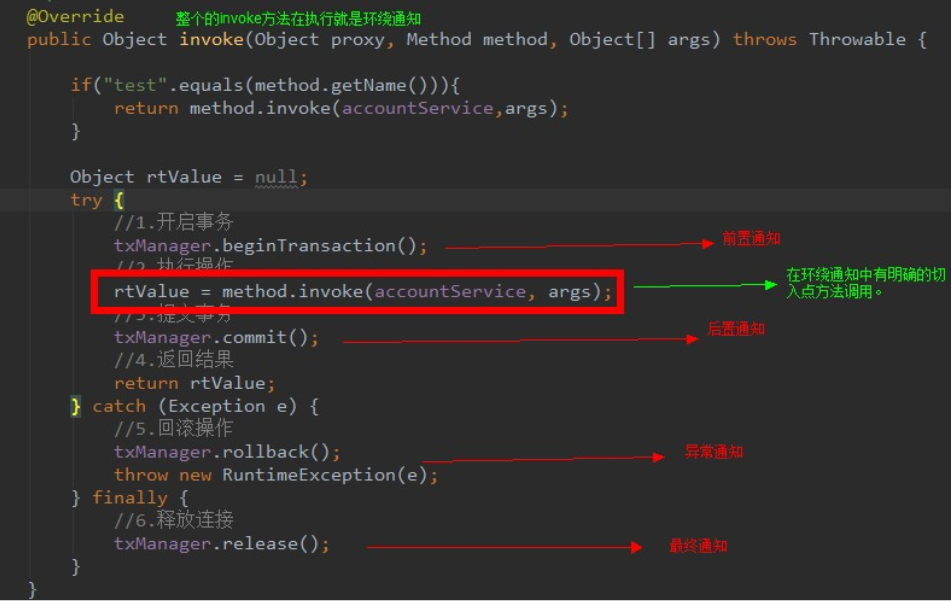
这个是我们前面讲的基于动态代理的通知
- 我们发现环绕通知就是这整个方法
- 里面包含着
- 前置通知
- 方法调用
- 后置通知
- 异常通知
- 最终通知
所以环绕通知在
Spring中的地位非同一般
首先我们需要注意几件事:
- 既然环绕通知包含了这些东西,那么也就代表着在
spring中可以在环绕通知中配置其他的通知- 既然上面的动态代理图片中有明确的方法调用,所以在环绕通知中也应该进行方法调用,要不然就不会进行方法执行
掌握了以上几件事,我们开始敲代码
- bean.xml
<?xml version="1.0" encoding="UTF-8"?>
<beans xmlns="http://www.springframework.org/schema/beans"
xmlns:xsi="http://www.w3.org/2001/XMLSchema-instance"
xmlns:aop="http://www.springframework.org/schema/aop"
xsi:schemaLocation="http://www.springframework.org/schema/beans
https://www.springframework.org/schema/beans/spring-beans.xsd
http://www.springframework.org/schema/aop
https://www.springframework.org/schema/aop/spring-aop.xsd">
<bean id="accountService" class="com.bean.service.impl.AccountServiceImpl"></bean>
<bean id="logger" class="com.bean.utils.Logger"></bean>
<aop:config>
<aop:pointcut id="pointCut" expression="execution(* com.bean.service.impl.*.*(..))"></aop:pointcut>
<aop:aspect id="logAdvice" ref="logger">
<!--只配置了一个环绕通知,环绕通知的标签就是<aop:around></aop:around>-->
<aop:around method="aroudnPrintLog" pointcut-ref="pointCut"></aop:around>
</aop:aspect>
</aop:config>
</beans>
- Logger
package com.bean.utils;
import org.aspectj.lang.ProceedingJoinPoint;
/**
* 模拟用于记录日志的工具类,里面提供了公共代码
*/
public class Logger {
/*
* 我们刚才在事项里面说到
* 1. 环绕通知必须要进行方法调用,否则方法不会执行
* 2. 观看之前我们写的基于动态代理执行的方法,我们也可以进行其他四种通知的调用
* 3. 我们也要有返回值
*
* 既然要进行方法调用,就要有参数
* ProceedingJoinPoint就是参数,用于获取方法
* - proceed():参数下面有一个方法proceed(),这个就相当于明确调用切入点方法
* - getArgs():用于获取切入点点方法的参数
* */
public Object aroudnPrintLog(ProceedingJoinPoint proceedingJoinPoint){
Object returnValue = null;
try {
System.out.println("这叫前置通知");
returnValue = proceedingJoinPoint.proceed(proceedingJoinPoint.getArgs()); //这叫切入点方法调用
System.out.println("这叫后置通知");
} catch (Throwable throwable) {//注意这里使用的是Throwable,因为Exception拦不住它
System.out.println("这叫异常通知");
throwable.printStackTrace();
}finally {
System.out.println("这叫最终通知");
}
return returnValue;
}
}
# 基于注解的AOP配置
# 快速起步
1、需要更改一下约束条件
<?xml version="1.0" encoding="UTF-8"?>
<beans xmlns="http://www.springframework.org/schema/beans"
xmlns:xsi="http://www.w3.org/2001/XMLSchema-instance"
xmlns:aop="http://www.springframework.org/schema/aop"
xmlns:context="http://www.springframework.org/schema/context"
xsi:schemaLocation="http://www.springframework.org/schema/beans
https://www.springframework.org/schema/beans/spring-beans.xsd
http://www.springframework.org/schema/aop
https://www.springframework.org/schema/aop/spring-aop.xsd
http://www.springframework.org/schema/context
https://www.springframework.org/schema/context/spring-context.xsd">
</beans>
2、加入bean对象并且配置注解
- service
package com.bean.service.impl;
import com.bean.service.IAccountService;
import org.springframework.stereotype.Service;
@Service
public class AccountServiceImpl implements IAccountService {
public void saveAccount() {
System.out.println("保存方法执行了");
}
public void updateAccount(int i) {
System.out.println("更新方法执行了"+i);
}
public int deleteAccount() {
System.out.println("删除方法执行了");
return 0;
}
}
- Logger
package com.bean.utils;
import org.aspectj.lang.ProceedingJoinPoint;
import org.aspectj.lang.annotation.*;
import org.springframework.stereotype.Component;
/**
* 模拟用于记录日志的工具类,里面提供了公共代码
*/
@Component//加入bean
@Aspect//注意,这里制定了这个Logger类是一个切面类
public class Logger {
@Pointcut("execution(* com.bean.service.impl.*.*(..))")//配置切面表达式,id就是方法名称
public void AspectPointCut(){};
/**
* 前置通知
*/
@Before("AspectPointCut()")//指定前置通知,注意看好包,配置了切面表达式,注意一定要加括号
public void beforePrintLog(){
System.out.println("Logger类中的前置通知方法开始记录日志了。。。。。。");
}
/**
* 后置通知通知
*/
@AfterReturning("AspectPointCut()")//指定后置通知,配置切面表达式,注意加括号
public void afterReturningPrintLog(){
System.out.println("Logger类中的后置通知开始记录日志了。。。。。。");
}
/**
* 异常通知
*/
@AfterThrowing("AspectPointCut()")//指定异常通知,配置切面表达式,注意加括号
public void afterThrowsPrintLog(){
System.out.println("Logger类中的异常通知方法开始记录日志了。。。。。。");
}
/**
* 最终通知
*/
@After("AspectPointCut()")//指定最终通知,配置切面表达式,注意加括号
public void afterPrintLog(){
System.out.println("Logger类中的最终通知方法开始记录日志了。。。。。。");
}
//环绕通知
@Around("AspectPointCut()")//指定环绕通知,配置切面表达式,注意加括号
public Object aroudnPrintLog(ProceedingJoinPoint proceedingJoinPoint){
Object returnValue = null;
try {
System.out.println("这叫前置通知");
returnValue = proceedingJoinPoint.proceed(proceedingJoinPoint.getArgs()); //这叫切入点方法调用
System.out.println("这叫后置通知");
} catch (Throwable throwable) {//注意这里使用的是Throwable,因为Exception拦不住它
System.out.println("这叫异常通知");
throwable.printStackTrace();
}finally {
System.out.println("这叫最终通知");
}
return returnValue;
}
}
- AOPTest
package com.bean.test;
import com.bean.service.IAccountService;
import com.bean.service.impl.AccountServiceImpl;
import org.springframework.context.ApplicationContext;
import org.springframework.context.annotation.AnnotationConfigApplicationContext;
import org.springframework.context.support.ClassPathXmlApplicationContext;
public class AOPTest {
public static void main(String[] args) {
ApplicationContext context = new ClassPathXmlApplicationContext("bean.xml");
IAccountService accountService = (IAccountService) context.getBean("accountServiceImpl");
accountService.saveAccount();
}
}
# AOP注解中的问题,实际开发中应该怎么做
其实虽然注解好用,但是我不得不告诉你,Spring在完全使用注解方式执行AOP的时候会出现问题,就是顺序调用问题,比如下面的
Logger类中的前置通知方法开始记录日志了。。。。。。
保存方法执行了
Logger类中的最终通知方法开始记录日志了。。。。。。
Logger类中的后置通知开始记录日志了。。。。。。
- 这是不使用环绕通知的时候进行的测试,代码写的没有问题,但是调用顺序出错了,其实是
Spring有问题 - 调用顺序为:前置通知-->最终通知-->后置通知
- 所以假如使用注解,可能会出现问题
所以在这个方法下,采用半注解半代码的形式来配置(注解环绕通知)或者使用xml的形式,便可以避免调用顺序出错的问题
# 使用纯注解
1、首先看一下前面的不使用xml的时候使用的配置类
2、然后在配置类上加上一个@EnableAspectJAutoProxy来配置好切面类
3、下面是一个例子
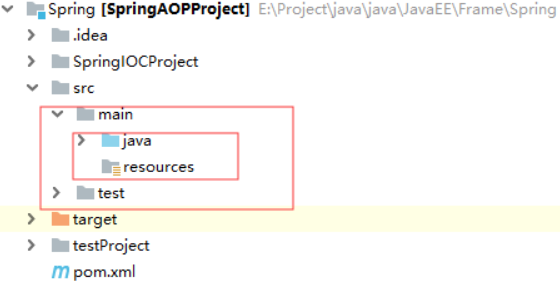
- java.config.SpringConfiguration
package config;
import org.springframework.context.annotation.ComponentScan;
import org.springframework.context.annotation.Configuration;
import org.springframework.context.annotation.EnableAspectJAutoProxy;
@Configuration
@ComponentScan("com.bean")
@EnableAspectJAutoProxy
public class SpringConfiguration {
}
- java.com.bean.service.impl.AccountServiceImpl
package com.bean.service.impl;
import com.bean.service.IAccountService;
import org.springframework.stereotype.Service;
@Service
public class AccountServiceImpl implements IAccountService {
public void saveAccount() {
System.out.println("保存方法执行了");
}
public void updateAccount(int i) {
System.out.println("更新方法执行了"+i);
}
public int deleteAccount() {
System.out.println("删除方法执行了");
return 0;
}
}
- java.com.bean.utils.Logger
package com.bean.utils;
import org.aspectj.lang.ProceedingJoinPoint;
import org.aspectj.lang.annotation.*;
import org.springframework.stereotype.Component;
/**
* 模拟用于记录日志的工具类,里面提供了公共代码
*/
@Component//加入bean
@Aspect//注意,这里制定了这个Logger类是一个切面类
public class Logger {
@Pointcut("execution(* com.bean.service.impl.*.*(..))")//配置切面表达式,id就是方法名称
public void AspectPointCut(){};
/**
* 前置通知
*/
@Before("AspectPointCut()")//指定前置通知,注意看好包,配置了切面表达式,注意一定要加括号
public void beforePrintLog(){
System.out.println("Logger类中的前置通知方法开始记录日志了。。。。。。");
}
/**
* 后置通知通知
*/
@AfterReturning("AspectPointCut()")//指定后置通知,配置切面表达式,注意加括号
public void afterReturningPrintLog(){
System.out.println("Logger类中的后置通知开始记录日志了。。。。。。");
}
/**
* 异常通知
*/
@AfterThrowing("AspectPointCut()")//指定异常通知,配置切面表达式,注意加括号
public void afterThrowsPrintLog(){
System.out.println("Logger类中的异常通知方法开始记录日志了。。。。。。");
}
/**
* 最终通知
*/
@After("AspectPointCut()")//指定最终通知,配置切面表达式,注意加括号
public void afterPrintLog(){
System.out.println("Logger类中的最终通知方法开始记录日志了。。。。。。");
}
//环绕通知
@Around("AspectPointCut()")//指定环绕通知,配置切面表达式,注意加括号
public Object aroudnPrintLog(ProceedingJoinPoint proceedingJoinPoint){
Object returnValue = null;
try {
System.out.println("这叫前置通知");
returnValue = proceedingJoinPoint.proceed(proceedingJoinPoint.getArgs()); //这叫切入点方法调用
System.out.println("这叫后置通知");
} catch (Throwable throwable) {//注意这里使用的是Throwable,因为Exception拦不住它
System.out.println("这叫异常通知");
throwable.printStackTrace();
}finally {
System.out.println("这叫最终通知");
}
return returnValue;
}
}
- test.com.bean.test.AOPTest
package com.bean.test;
import com.bean.service.IAccountService;
import com.bean.service.impl.AccountServiceImpl;
import config.SpringConfiguration;
import org.springframework.context.ApplicationContext;
import org.springframework.context.annotation.AnnotationConfigApplicationContext;
import org.springframework.context.support.ClassPathXmlApplicationContext;
public class AOPTest {
public static void main(String[] args) {
ApplicationContext context = new AnnotationConfigApplicationContext(SpringConfiguration.class);
IAccountService accountService = (IAccountService) context.getBean("accountServiceImpl");
accountService.saveAccount();
}
}


